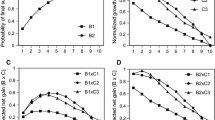Abstract
Intake rates of snow buntings feeding on artificial seed patches were measured at different bird densities, for each of two different seed densities. Interference occurred in the low seed-density treatment, with intake rates declining at high bird densities. However, interference was not found in the high seeddensity treatment. The finding that the strength of interference may depend on resource density contradicts the hypothesis that the functional response is ratio-dependent (Arditi and Akçakaya 1990). The formulation for interference from Hassell and Varley (1969), and the models of Beddington (1975), Ruxton et al. (1992) and Holmgren (1995), also assume that the strength of interference is independent of resource density. The development of behaviour-based models that consider the relation between the intensity of interference, resource density and individual state may provide a more accurate description of the process of interference.
Similar content being viewed by others
References
Arditi R, Akçakaya HR (1990) Underestimation of mutual interference of predators. Oecologia 83: 358–361
Arditi R, Ginzburg LR (1989) Coupling in predator-prey dynamics: ratio-dependence. J Theor Biol 139: 311–326
Baker MC, Belcher CS, Deutsch LC, Sherman GL, Thompson DB (1981) Foraging success in junco flocks and the effects of social hierarchy. Anim Behav 29: 137–142
Banks K, Clark H, Mackay IRK, Mackay SG, Sellers RM (1990) Ageing, sexing and racing snow buntings in winter plumage. Ringers Bull 7: 84–87
Beddington JR (1975) Mutual interference between parasites or predators and its effect on searching efficiency. J Anim Ecol 44: 331–340
Bernstein C, Kacelnik AJ, Krebs JR (1988) Individual decisions and the distribution of predators in a patchy environment. J Anim Ecol 57: 1007–1026
Bernstein C, Kacelnik AJ, Krebs JR (1991) Individual decisions and the distribution of predators in a patchy environment. II. The influence of travel costs and structure of the environment. J Anim Ecol 60: 205–225
Caraco T (1979) Time budgeting and group size: a test of theory. Ecology 60: 618–627
DeAngelis DL, Goldstein RA, O'Neill RV (1975) A model for trophic interaction. Ecology 56: 881–892
Ekman J (1984) Density-dependent seasonal mortality and population fluctuations of the temperate-zone willow tit (Parus montanus). J Anim Ecol 53: 119–134
Ekman J (1990) Alliances in winter flocks of willow tits; effects of rank on survival and reproductive success in male-female associations. Behav Ecol Sociobiol 26: 239–245
Gauthreaux SA Jr (1978) The ecological significance of behavioural dominance. In: Bateson PPG, Klopfer PH (eds) Perspectives in ethology, vol 3: social behaviour. Plenum, New York, pp 17–54
Goss-Custard JD (1980) Competition for food and interference among waders. Ardea 68: 31–52
Goss-Custard JD, Clark RT, Durrell SEA Le V dit (1984) Rates of food intake and aggression of oystercatchers Haematopus ostralegus on the most and least preferred mussel Mytilus edulis beds of the Exe Estuary. J Anim Ecol 53: 233–245
Goss-Custard JD, Caldow RWG, Clarke RT, Durell SEA Le V dit, Sutherland WJ (1995) Deriving population parameters from individual variations in foraging behaviour. I. Empirical game theory distribution model of oystercatchers Haematopus ostralegus feeding on mussels Mytilus edulis. J Anim Ecol 64: 265–276
Hassell MP, Varley GC (1969) New inductive population model for insect parasites and its bearing on biological control. Nature 223: 1133–1136
Holmgren N (1995) The ideal free distribution of unequal competitors: predictions from a behaviour based functional response. J Anim Ecol 64: 197–212
Kotrschal K, Hemetsberger J, Dittami J (1993) Food exploitation by a winter flock of greylag geese: behavioural dynamics, competition and social status. Behav Ecol Sociobiol 33: 289–295
Metcalfe NB, Wright PJ, Thorpe JE (1992) Relationships between social status, otolith size at first feeding and subsequent growth in Atlantic salmon (Salmo salar). J Anim Ecol 61: 585–589
Monaghan P (1980) Dominance and dispersal between feeding sites in the herring gull (Larus argentatus). Anim Behav 28: 521–527
Parker GA, Sutherland WJ (1986) Ideal free distributions when individuals differ in competitive ability: phenotype limited ideal free models. Anim Behav 34: 1222–1242
Royama T (1971) Evolutionary significance of predators' response to local differences in prey density: a theoretical study. In: Boer PJ den, Gradwell GR (eds) Dynamics of populations. Centre for Agricultural Publishing and Documentation, Wageningen, pp 344–357
Ruxton GD, Gurney WSC, De Roos AM (1992) Interference and generation cycles. Theor Popul Biol 42: 235–253
Selman J, Goss-Custard JD (1988) Interference between foraging redsank Tringa totanus. Anim Behav 36: 1542–1544
Smith RD (1992) Age determination, wing-feather colour and winglength change in snow buntings Plectrophenax nivalis. Ringing Migr 13: 43–51
Sutherland WJ (1983) Aggregation and the ideal free distribution. J Anim Ecol 52: 821–828
Sutherland WJ, Dolman PM (1994) Combining behaviour and population dynamics with applications for predicting consequences of habitat loss. Proc R Soc Lond B 255: 133–138
Sutherland WJ, Koene P (1982) Field estimates of the strength of interference between oystercatchers Haematopus ostralegus. Oecologia 55: 108–109
Author information
Authors and Affiliations
Rights and permissions
About this article
Cite this article
Dolman, P.M. The intensity of interference varies with resource density: evidence from a field study with snow buntings, Plectrophenax nivalis . Oecologia 102, 511–514 (1995). https://doi.org/10.1007/BF00341364
Received:
Accepted:
Issue Date:
DOI: https://doi.org/10.1007/BF00341364




